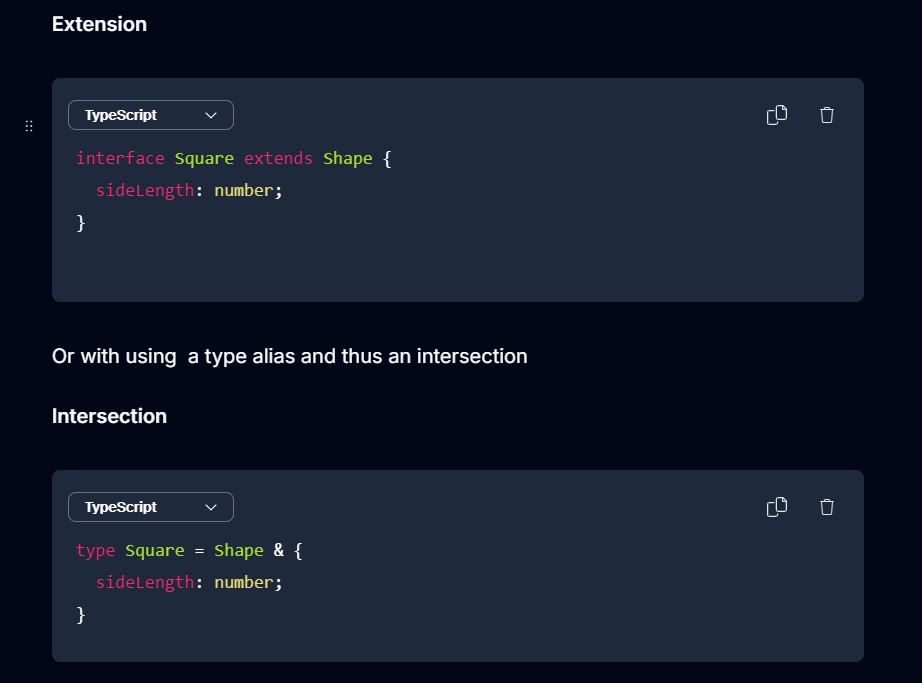Difference between extending and intersecting interfaces in TypeScript?
 Carmine Tambascia
Carmine Tambascia
Have you ever found yourself thinking in a complex project asking this question, then in this article I will try to answer with examples
Let's say the following type is defined:
interface Shape {
color: string;
}
Now, maybe we need a way to abstract further some properties but still keep them reusable as type, like in the following ways to add additional properties to this type:
We could go for an
Extension
interface Square extends Shape {
sideLength: number;
}
Or with using a type alias and thus an intersection
Intersection
type Square = Shape & {
sideLength: number;
}
Then what is the difference between both approaches?
Which one is better to use when or they basically in practice do not make any difference?
Let's start saying that there are differences which may or may not be relevant in a particular scenario.
Perhaps the most significant is the difference in how members with the same property key are handled when present in both types.
Consider:
interface NumberToStringConverter {
convert: (value: number) => string;
}
interface BidirectionalStringNumberConverter extends NumberToStringConverter {
convert: (value: string) => number;
}
The extends above results in an error because the deriving interface declares a property with the same key as one in the derived interface but with an incompatible signature.
error TS2430: Interface 'BidirectionalStringNumberConverter' incorrectly extends interface 'NumberToStringConverter'.
Types of property 'convert' are incompatible.
Type '(value: string) => number' is not assignable to type '(value: number) => string'.
Types of parameters 'value' and 'value' are incompatible.
Type 'number' is not assignable to type 'string'.
However, if we employ intersection types
type NumberToStringConverter = {
convert: (value: number) => string;
}
type BidirectionalStringNumberConverter = NumberToStringConverter & {
convert: (value: string) => number;
}
There is no error whatsoever and, furthermore, this is useful indeed as a value conforming to this particular intersection type is easily conceived of.
const converter: BidirectionalStringNumberConverter = {
convert: (value: string | number) => {
return (
typeof value === 'string'
? Number(value)
: String(value)
) as string & number; // type assertion is an unfortunately necessary hack.
}
}
Note that the implementation of the intersection, as shown above, involves some awkward types and assertions but these are purely implementation artifacts which do not contribute to the type of the converter object which is solely determined by the type BidirectionalStringNumberConverter used to annotate the object literal converter.
let's see this applied:
const s: string = converter.convert(0); // `convert`'s call signature comes from `NumberToStringConverter`
const n: number = converter.convert('a'); // `convert`'s call signature comes from `BidirectionalStringNumberConverter`
Another important difference, interface declarations are open ended. New members can be added anywhere because multiple interface declarations with same name in the same declaration space are merged. This is in direct contrast to type expression produced by & which creates an anonymous expression that can be bound to an alias for reuse but not augmented via merging.
Here is a common use for merging behavior
lib.d.ts
interface Array<T> {
// map, filter, etc.
}
array-flat-map-polyfill.ts
interface Array<T> {
flatMap<R>(f: (x: T) => R[]): R[];
}
if (typeof Array.prototype.flatMap !== 'function') {
Array.prototype.flatMap = function (f) {
// Implementation simplified for exposition.
return this.map(f).reduce((xs, ys) => [...xs, ...ys], []);
}
}
Notice how no extends clause is present, although specified in separate files the interfaces are both in the global scope and are merged by name into a single logical interface declaration that has both sets of members. (the same can be done for module scoped declarations with slightly different syntax)
By contrast, intersection types, as stored in a type declaration, are closed, not subject to merging.
There are many, many differences. You can read more about both constructs in the TypeScript Handbook. The Object Types and the Creating Types from Types sections are particularly relevant.
Subscribe to my newsletter
Read articles from Carmine Tambascia directly inside your inbox. Subscribe to the newsletter, and don't miss out.
Written by
